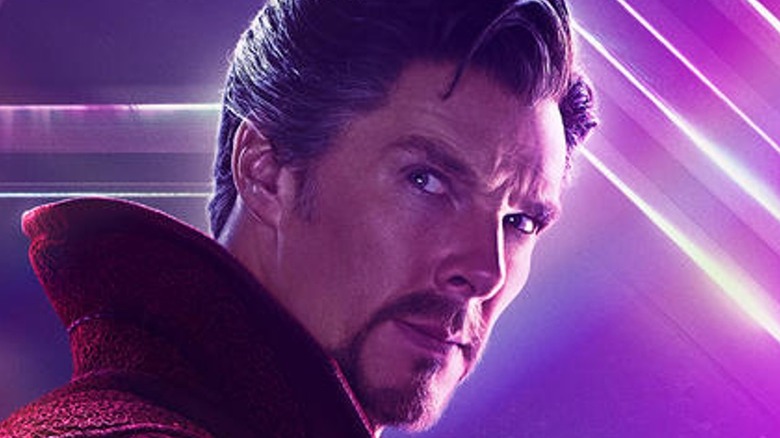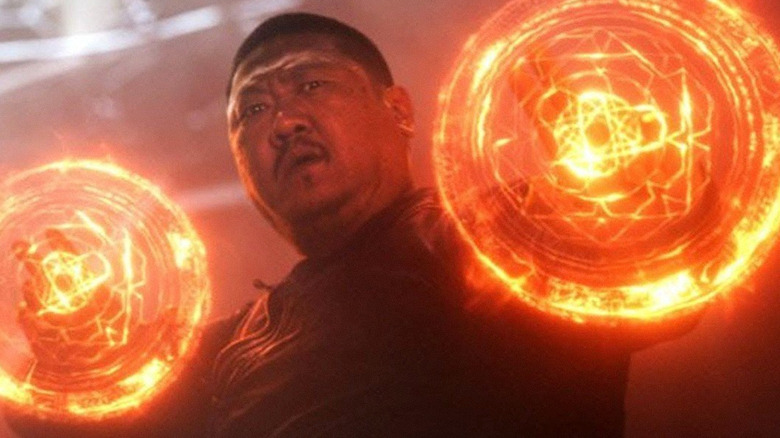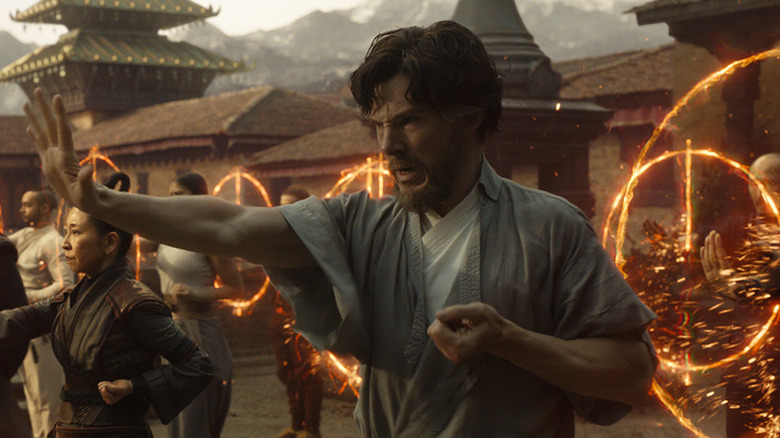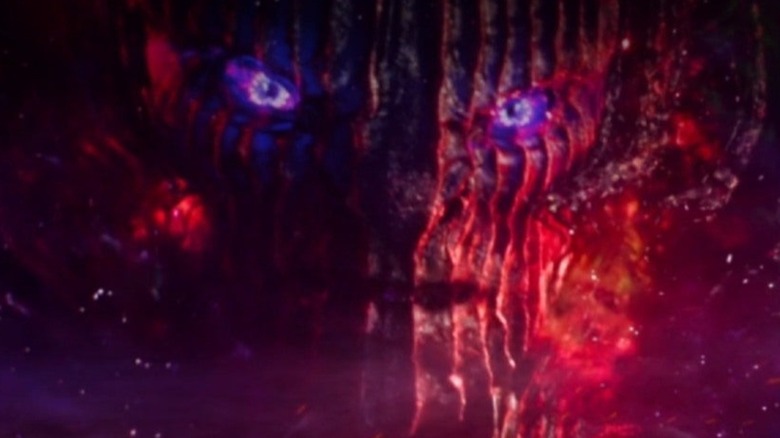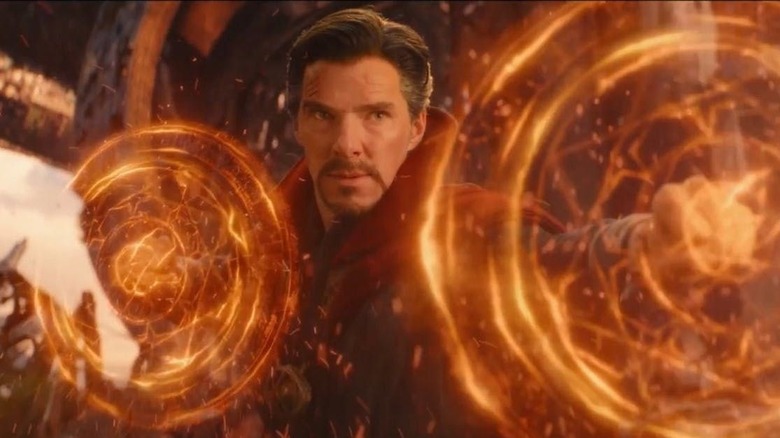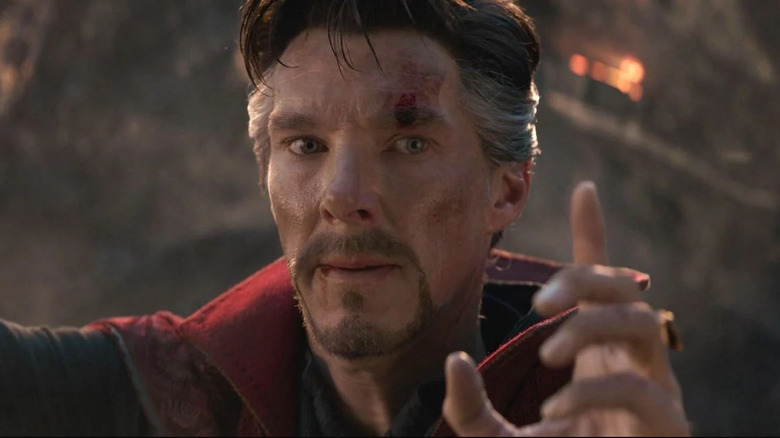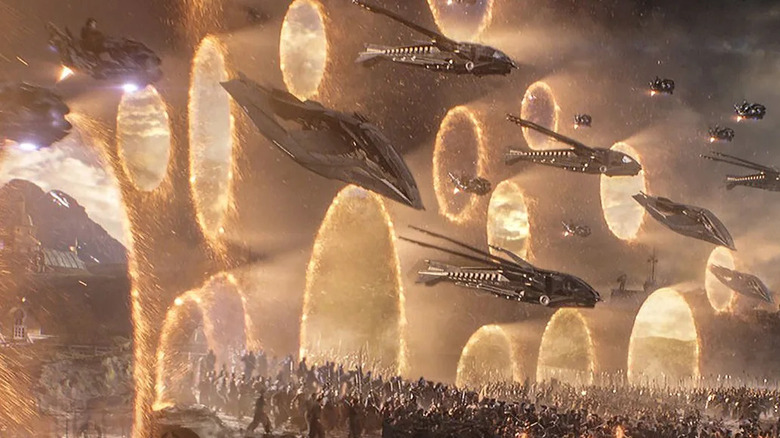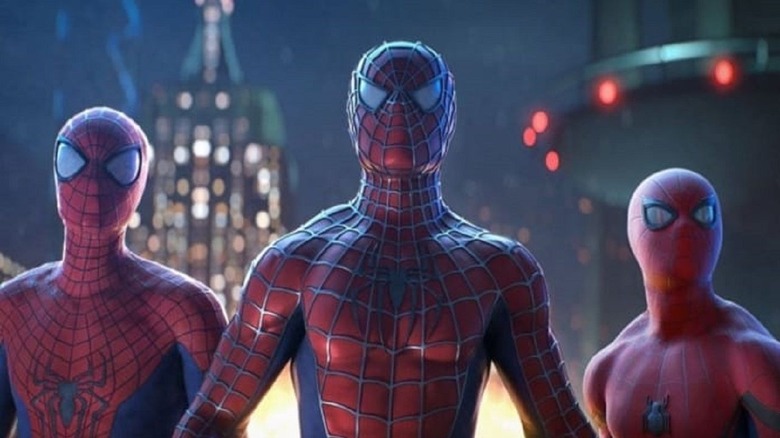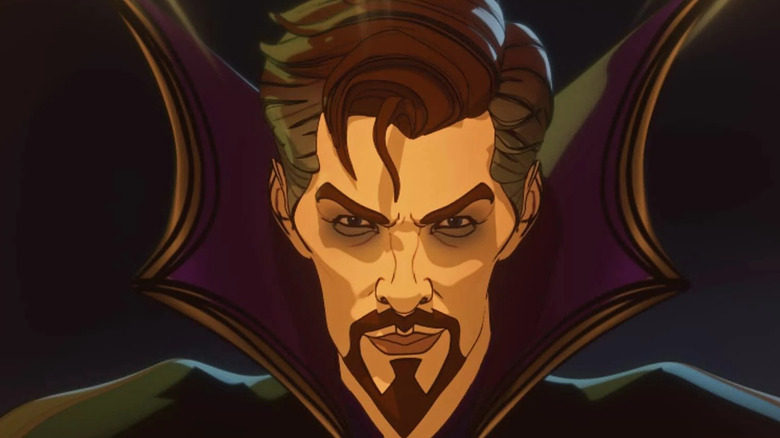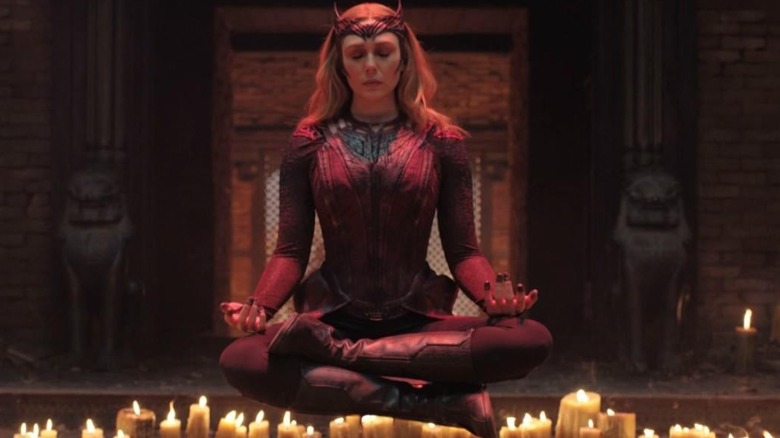Doctor Strange's Entire Timeline In The MCU Explained
The Marvel Cinematic Universe is breaking apart. What was once one timeline has become several, and the singular universe that was home to the galaxy's greatest heroes has revealed itself to be one of many in a vast multiverse. That makes the task of keeping track of the whens and wheres increasingly difficult, especially for those at the center of all the existential entanglement. There are few characters more central to the complexities of the MCU multiverse than Doctor Strange, and after the events of "Doctor Strange in the Multiverse of Madness," the hero is virtually guaranteed to become the heart of it all.
Like the MCU itself, Doctor Strange has had a long, storied history, filled to the brim with momentous occasions and significant battles. As dense as that history can seem, and especially considering MCU architect Kevin Feige's waffling over its exact order, the whole sequence of events can be ordered neatly and its dates firmly placed. Though the sea of stories in the Marvel multiverse is only getting deeper by the movie, the sequence of events for Doctor Strange can be your life raft and compass. Here, we explain Doctor Strange's entire timeline in the MCU.
Setting up Stephen
It starts when the universe was still young. Though it may seem weird to start a person's history in a period before they were even a person, Strange — wielder of ancient magics, vanquisher of ancient foes, and star pupil of someone literally called the Ancient One — is a character deeply rooted in the past.
More than any other hero, Strange's abilities are drawn from the past, and he's always quick to mention it. Ever the know-it-all and braggart, Strange often cites the ancient magicians and otherworldly beings from whom his spells originated. The Crimson Bands of Cyttorak, the Winds of Watoom, the Images of Ikonn, and a hoary host of other spells all serve as constant links between Strange and the MCU's past. The same is true for many of his various relics, such as the Cloak of Levitation, the Eye of Agamotto, and the Book of Cagliostro. And for Strange, the very source of the supernatural side of his life is the Ancient One and the equally ancient city of Kamar-Taj, both existing for at least "hundreds and hundreds of years," per Feige. Strange was not the sole Sorcerer Supreme, but rather one being in a long line of inheritors.
The doctor is in
Despite the immemorial beginnings of magic in the MCU, as well as its periodic flare-ups on Earth, such as in AD 965 in Tonsberg, Norway, Stephen Strange spent the first few decades of his life completely ignorant of its existence. All the way up until his inevitable first encounter with the mystic arts, Strange refused to believe in "fairy tales" and accepted the existence of "matter and nothing more."
His steadfast devotion to science and medicine, alongside his exceptional intelligence, served Strange well, and by 2016, during "Doctor Strange," he was one of the world's top neurosurgeons. And he likely stood at the top for years, as his skills and notoriety had earned him a spot on a HYDRA watchlist at least as early as 2014. Even before he became a sorcerer, Strange's cleverness and peculiarity made him a player on the superhero stage. And going even further back, we can place Strange's whereabouts during the 2012 Chitauri invasion of New York, as seen in "The Avengers." As part of the time heist in "Avengers: Endgame," the Hulk visits the Sanctum Sanctorum in 2012 in order to find Stephen. There, the Ancient One tells Hulk that he's "about five years too early. Stephen Strange is currently performing surgery about 20 blocks [away]."
Getting Strange
In 2016, during "Doctor Strange," Strange's life turned upside down when a car accident cost him the full use of his hands, thereby ending his career as a neurosurgeon. Broken and dejected but still as headstrong as ever, Strange sought out any and every remedy for his condition. After exhausting all his traditional options, Strange threw the ultimate Hail Mary and flew to Nepal, following rumors of miraculous healers in the hidden city of Kamar-Taj.
There, Strange was forcibly divested of his narrow concepts of reality and began studying magic in earnest. Strange approached his magical studies as he had his medical studies, accelerating the prescribed syllabus and devouring every source of information he could, which led to him developing a relationship with the librarian-sorcerer Wong. During his studies, Strange also developed a friendship with the sorcerer Mordo, mastered the use of portals via the magical Sling Ring, first used the Eye of Agamotto (later revealed to be the Time Stone), and learned of the dangers inherent in the use of dark magic — all of which would prove critical in Strange's later exploits.
Dark Dimension and Sorcerer Supreme
Strange's studies came to an abrupt end when the rogue sorcerer Kaecilius started attacking the various magical Sanctums that guarded the Earth in his bid to summon the Dread Dormammu — and, in so doing, gain immortality. Between the attack and subsequent battles, such as the kaleidoscopic fight in the Mirror Dimension, much of the groundwork for Strange's transformation into a true superhero was laid.
The previous guardian of the Sanctum Sanctorum, Daniel Drumm, was murdered, leading to Strange inheriting the position. While battling Kaecilius in the Sanctum, the Cloak of Levitation — the most memorable piece of Doctor Strange's costume — chose him as its new wearer. Most importantly of all, the Ancient One passed away in combat with Kaecilius, leaving Strange as the new Sorcerer Supreme (or as close to the title as he could get while still a magical neophyte), as well as the new protector of the Time Stone.
His first responsibilities were twofold: stop Kaecilius and his rogue sorcerers from bringing the Dark Dimension to Earth, and defeat the evil Dormammu. With the aid of Wong, Mordo, and the Time Stone, Strange succeeded in both tasks — the latter of which he managed through a unique combination of cleverness and annoyance.
Thor, Loki, and Odin
In 2017, during "Thor: Ragnarok," Strange first encountered the Asgardians Thor and Loki. Though only a few months into his new role, Strange had already begun compiling a list of potential threats to Earth, and Loki's 2012 attack on New York City earned him one of the top spots. When Thor and Loki traveled to Earth in search of their father Odin, Strange detected their inhuman presence and within a minute had trapped Loki in a self-contained, endless freefall as a precaution. Leaving his card behind for Thor, Strange invited the thunder god to visit the Sanctum Sanctorum.
Once there, Thor explained to Strange his quest to locate Odin, and Strange's reply subtly implied the level to which he was mastering his new duties. He told Thor that he knew where Odin was but that "he was adamant that he not be disturbed. Your father said that he had chosen to remain in exile." In just a few sentences, Strange revealed that he had dared to confront the All-Father when he arrived on Earth, and that their meeting was enough for Strange to earn Odin's respect and confidence. The king of the gods trusted Strange alone with his secret, a secret Strange kept until the next king, Thor, had need of it.
The Infinity War
"Thor: Ragnarok" ends with Thanos' ship, Sanctuary II, looming over the vessel that carries the last Asgardian survivors. The ensuing attack then opens up "Avengers: Infinity War," placing the two films just moments apart. As his last act before being murdered by Thanos' Black Order, Heimdall sends Bruce Banner to Earth — specifically to the residence of one of Thor's newest allies, Doctor Strange.
Banner warns Strange of Thanos' imminent arrival on Earth in search of the Infinity Stones, and thus the Infinity War begins. Strange is a key player throughout, accompanying Iron Man and Spider-Man as they travel to confront Thanos on Titan. The trio, after joining up with the Guardians of the Galaxy — on Titan for the same reason — battles Thanos, who is by then in possession of four of the Infinity Stones. Strange plays perhaps the biggest role in the fight, not just as one of its strongest participants, but also for scanning alternate futures to determine the single course of events that will lead to Thanos's defeat. Strange's final act before the conflict's conclusion and his subsequent Blipping is giving Thanos the Time Stone, a decision many found foolish but one which Strange knew to be the only way.
Blipped
The events of "Avengers: Infinity War" last long enough to reach 2018, as evidenced by a number of onscreen dialogues and confirmed by Feige. The film ends with the Blip, in which half of all life disappears in moments. In several films and TV shows, characters explicitly state that the Blip lasted five years, and a dramatically emphasized title card in "Avengers: Endgame" makes that clear as well. As Thanos Blipped Strange, he spent 2018 to 2023 simply not existing. As shown in "Black Widow," those who were Blipped didn't notice the passage of time at all, and so to Strange, one moment it was 2018, and the next it was 2023.
During Strange's five-year absence, the remaining population of the universe carried on, and a few notable events took place. Two are of particular importance, as they undoubtedly featured in Strange's tour of alternate futures. First, around a month after the Blip, the remaining Avengers locate Thanos and kill him, but not before learning that the Infinity Stones are all destroyed. The second, and universally critical, event of note takes place five years after the Blip, when Scott Lang is finally freed from the Quantum Realm and returns to Earth.
The Endgame
Lang's return and his first-hand knowledge of the reality of time travel kicks off the 2023 events of "Avengers: Endgame." For most of the film, Strange is still blipped, but then a mostly successful time heist gathers the Infinity Stones for the Avengers, allowing the Hulk to snap and bring back everyone Thanos Blipped. Soon after, Thanos attacks Avengers Compound, and Strange plays a crucial role in his defeat.
Knowing how the entire sequence of events had to play out, Strange recovers from the Blip faster than most. He quickly begins gathering the Blipped heroes from across the galaxy, as well as recruiting an army comprised of sorcerers, Ravagers, and Wakandans. Using his mastery of portal teleportation, Strange gathers all the allied armies and heroes to Avengers Compound, leading to the final, epic battle against Thanos and his forces.
During the battle, Strange is in position to remind Stark that there's only one successful path to victory, the details of which Stark instinctively understands. Stark seizes the Stones and Blips away Thanos and his armies, sacrificing himself in the process. A few days later, Strange and Wong attend Stark's funeral as the Infinity Saga officially concludes.
With Spider-Man
Soon after his return to existence, Strange learns that he is no longer the Sorcerer Supreme. As he had been nonexistent for five years, the title had passed to Wong, in what Strange described as "a technicality." Though no longer the Earth's leading sorcerer, Strange is still an exceptional magician and comes to the aid of Peter Parker when he needs magical help.
In 2024, during the events of "Spider-Man: No Way Home," Strange attempts to cast a spell to once more conceal Parker's secret identity. Due to Parker's interference, the spell goes awry, leading to a series of cracks in the structure of the multiverse. Due to Strange's magic, beings from other universes begin crossing over onto the MCU's main Earth, and though he's no longer the Sorcerer Supreme, Strange sets out to remove the aberrations. He and Parker disagree over the fate of the multiversal beings, leading to a lengthy battle between the two and Strange being trapped in the Mirror Dimension. When he finally frees himself, Strange returns to Earth, fixes as much of the multiversal damage as he can, and finally casts the original spell to make Parker anonymous.
What If?
The "What If?" television series is unique in that it is firmly canon in the MCU but takes place in different universes than the other movies and shows. Most of its individual episodes even take place in different universes than each other, though they begin to overlap toward the season's end. And though "What If?" has its own versions of Doctor Strange that deserve their own chronicling, the events of the show look as though they are going to directly feed into our Doctor Strange's timeline in "Doctor Strange in the Multiverse of Madness."
The "What If?" episode "What If... Doctor Strange Lost His Heart Instead of His Hands" sees a version of Strange who lost longtime love Christine Palmer instead of his ability to perform surgery. This version of Strange tries to fix that loss with the same energy that our Strange used to master the mystic arts, except that Strange is burdened with far too much grief. His quest brings him unparalleled power, but only through the use of dark, predatory magic. Based on the trailers for "Multiverse of Madness," it looks like Dark Strange will return. Further, it looks like our Strange may possibly stoop to darker levels himself.
Multiverse of Madness
The events of "Spider-Man: No Way Home" take place in 2024, and the events of "Doctor Strange in the Multiverse of Madness" are set to directly follow them — Strange's damage to the multiverse in "No Way Home" is what kicks off the plot of "Multiverse of Madness." However, given that the "Hawkeye" series also takes place in 2024 — at its very end — and never mentions any multiverse-level war or giant, tentacled monster, it's possible that "Multiverse of Madness" could be set later, placing it in early 2025.
Whether it's set in 2024 or early 2025, "Multiverse of Madness" Strange's most crucial quest yet. Even the events of the Infinity Saga can't compete — half of the universe's population sounds like a lot until millions of universes' populations are on the line. Strange will encounter multiple versions of himself, team up with a potentially unstable Scarlet Witch, meet the multiverse-hopping heroine America Chavez, reunite with Mordo (for better or worse), and even potentially meet Marvel's infamous Illuminati. No matter what happens, it seems likely that Doctor Strange's timeline — or timelines — is/are far from over.
